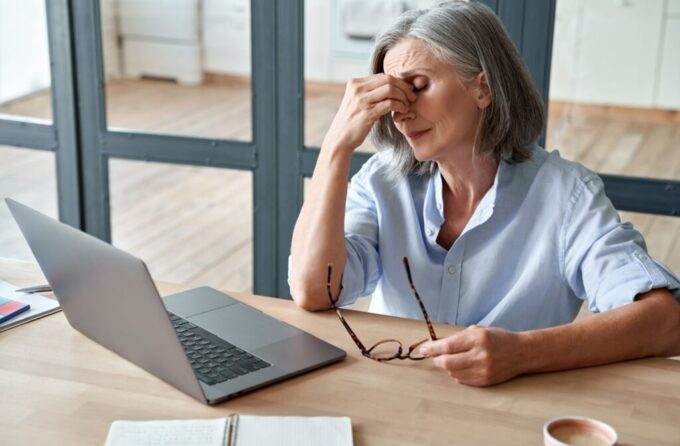Aging brings a range of challenges, and eyesight changes rank high on the list. Blurry details, sensitivity to light, and trouble reading small print signal the need for better eye care. Practical solutions help maintain independence and prevent complications.
Key Points:
- Regular eye exams detect issues early.
- Proper nutrition supports eyesight longevity.
- Hydration and eye drops ease discomfort.
- Protective measures prevent strain and fatigue.
- Supplements provide additional benefits.
- Simple adjustments improve daily visibility.
- Managing conditions like glaucoma or cataracts reduces risks.
1. Support Vision With Proper Eye Health Supplement
Nutrients fuel the body, and the same applies to eyesight. Lutein, zeaxanthin, and omega-3 fatty acids protect against deterioration. Eye health supplement products provide targeted support, especially for those struggling with dry or tired eyes. Herbal formulations offer additional benefits by reducing oxidative stress and maintaining ocular hydration.
Many struggle to get enough nutrients from food alone. Supplements help bridge that gap, ensuring the body gets the necessary elements for maintaining clarity and focus.
Key Benefits
- Protects against age-related decline by supplying essential nutrients.
- Reduces inflammation and dryness, improving overall comfort.
- Strengthens eye tissue, preventing long-term deterioration.
2. Prioritize Regular Eye Exams

Source: oldsouthoptometry.com
Routine checkups prevent severe complications. Early detection of glaucoma, macular degeneration, or cataracts allows for prompt intervention. Eye specialists recommend yearly evaluations to track changes and prescribe necessary treatments. Delays in assessment lead to irreversible damage.
Many common issues develop gradually, so symptoms might not be obvious at first. Regular screenings help spot concerns early, preventing sudden declines in sight.
A simple visit to an optometrist can make all the difference.
3. Adjust Lighting for Better Clarity
Dimming bulbs and poor contrast worsen eyesight problems. Bright LED lights reduce strain, making tasks easier. Task lighting near reading areas and motion-sensor night lights enhance safety. Avoid harsh glares, and opt for warm, diffused illumination.
Harsh lighting often makes focusing harder, while poor lighting leads to unnecessary strain. The right balance reduces stress on the eyes and keeps visibility clear.
Practical tips:
- Use adjustable desk lamps for reading to ensure consistent brightness.
- Install automatic nightlights in hallways and bathrooms for improved safety.
- Replace dim bulbs with higher lumen options for better brightness and reduced strain.
4. Stay Hydrated to Prevent Dryness
Tears protect against irritation, but aging reduces natural moisture. Drinking enough water and using preservative-free lubricating drops relieve discomfort. Humidifiers also prevent excessive dryness, especially in heated indoor spaces.
Signs of dry eyes:
- Frequent itching or burning sensation.
- Blurry vision that improves with blinking.
- Increased sensitivity to wind or smoke.
Dehydration impacts the body in several ways, and the eyes feel the effects quickly. Staying hydrated ensures that tear production remains stable, reducing discomfort.
5. Manage Screen Time to Reduce Strain

Staring at screens for extended periods leads to discomfort. Frequent breaks using the 20-20-20 rule (every 20 minutes, look at something 20 feet away for 20 seconds) ease tension. Adjusting screen brightness and increasing font size also prevents fatigue.
With digital devices playing a central role in daily life, managing screen exposure is essential. The right habits prevent long-term strain and discomfort.
Steps to reduce digital eye strain:
- Position screens at arm’s length to avoid unnecessary strain.
- Increase text size on devices for easier reading and reduce squinting.
- Use blue light filtering glasses for additional protection and comfort.
6. Wear Protective Eyewear
Exposure to UV rays speeds up degeneration. Sunglasses with 100% UV protection shield delicate structures from harm. Blue light filters offer additional protection against digital exposure. Anti-glare coatings improve comfort when using screens or driving at night.
Many underestimate the importance of eye protection, but cumulative exposure leads to irreversible damage. Investing in high-quality eyewear minimizes risks significantly.
7. Maintain a Balanced Diet
Leafy greens, nuts, and fish provide essential nutrients for clear eyesight. Vitamin A, C, and E-rich foods lower the risk of deterioration. Processed foods, excessive sugar, and smoking accelerate problems, increasing the chances of complications.
Nutritional choices directly impact eye health. The right foods reduce inflammation, improve circulation, and provide antioxidants essential for maintaining sharpness.
8. Use Magnification Tools for Daily Tasks

Source: imagniphy.com
Struggling with fine print frustrates many individuals. Magnifying glasses, large-print books, and adjustable screen settings ease everyday tasks. Voice-to-text features and audiobooks provide additional convenience.
Technology offers many solutions for making life easier. Adapting small changes allows individuals to maintain independence despite eyesight concerns.
Practical uses:
- Electronic magnifiers make reading newspapers and labels easier.
- High-contrast keyboards assist with typing and visibility.
- Smart speakers help retrieve information without straining eyes.
9. Manage Chronic Conditions That Affect Eyesight
Diabetes and hypertension contribute to serious complications. Monitoring blood sugar and blood pressure prevents damage to delicate eye structures. Regular doctor visits and a healthy lifestyle reduce risks significantly.
Poor circulation affects eye tissues over time, causing vision-related complications. Addressing underlying health concerns ensures long-term stability.
10. Blink More Often to Reduce Eye Fatigue
Conscious blinking spreads moisture across the surface, reducing irritation. Prolonged screen use causes dryness. Reminding oneself to blink frequently and using artificial tears alleviates discomfort.
Many forget to blink when focused on screens or reading, causing dryness. Simple awareness makes a difference.
11. Improve Home Safety to Prevent Falls

Source: ukhomeimprovement.co.uk
Poor eyesight significantly increases the risk of accidents, making home safety adjustments essential. Hazards like loose rugs, cluttered floors, and poorly lit hallways turn everyday movement into a potential danger. A few modifications can drastically lower the chances of falls.
- Clear pathways – Remove unnecessary furniture, electrical cords, and obstacles that could cause tripping.
- Secure rugs and carpets – Use non-slip pads or double-sided tape to keep floor coverings firmly in place.
- Improve lighting – Install bright, energy-efficient bulbs in hallways, staircases, and entryways to enhance visibility. Nightlights in bedrooms and bathrooms help navigate in the dark.
- Install handrails and grab bars – Sturdy handrails on staircases and grab bars in bathrooms provide essential support, especially for those with impaired vision.
- Use contrasting colors for depth perception – Marking stair edges with bright or contrasting tape makes steps more visible, reducing the risk of misjudging depth.
Even minor visibility issues can lead to dangerous missteps. By taking proactive measures, serious falls and injuries can be prevented, allowing for a safer, more accessible living environment.
12. Treat Common Conditions Promptly
Glaucoma causes irreversible damage if untreated. Cataracts blur details, limiting independence. Seeking medical attention at the first sign of trouble prevents worsening symptoms. Delays often result in complications requiring invasive procedures.
Ignoring symptoms worsens outcomes. Seeking timely care prevents progression and maintains overall well-being.
13. Sleep Well for Optimal Eye Recovery
Rest allows tissues to repair. Poor sleep quality contributes to inflammation, swelling, and discomfort. Sticking to a bedtime routine and reducing screen exposure before sleep improves overall health.
Tired eyes signal the need for rest. Quality sleep rejuvenates eye cells, ensuring better performance during waking hours.
Conclusion
Preserving eyesight ensures independence and a higher quality of life. Simple changes, protective measures, and regular medical checkups reduce risks. Addressing issues early prevents long-term complications. Prioritizing wellness keeps eyesight clear for years to come.







